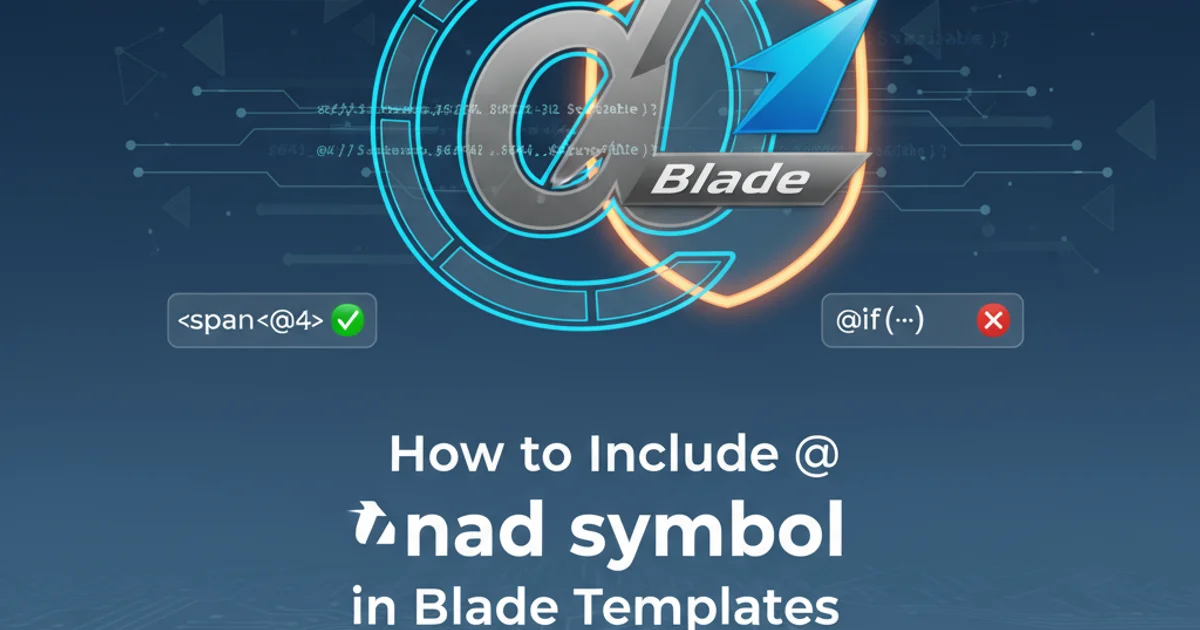How to Include @ symbol in blade template page without it being processed as blade code in Laravel
Categories:
How to Display the '@' Symbol in Laravel Blade Templates Without Processing

Learn effective techniques to render the '@' symbol literally in your Laravel Blade templates, preventing it from being interpreted as Blade syntax.
Laravel's Blade templating engine is powerful, using the @ symbol to denote directives like @if, @foreach, or @extends. However, this can become a challenge when you genuinely need to display the @ symbol as part of your content, such as in email addresses, social media handles, or JavaScript code, without Blade attempting to process it. This article explores several robust methods to achieve this, ensuring your content renders exactly as intended.
Understanding the Problem: Blade's Interpretation
Blade parses templates before they are served to the browser. Any text starting with @ is typically treated as a Blade directive. If Blade doesn't recognize the directive (e.g., @example.com), it might throw an error or simply render nothing, leading to unexpected output. The key is to tell Blade to ignore the @ symbol in specific contexts.
flowchart TD
A[Blade Template Render Request] --> B{Scan for '@' symbol}
B -->|Found '@'| C{Is it a known Blade directive?}
C -->|Yes| D[Process Blade Directive]
C -->|No| E{Is it escaped or literal?}
E -->|Yes (e.g., @@, @verbatim)| F[Render '@' literally]
E -->|No| G[Error or unexpected output]
F --> H[Output to Browser]
D --> HBlade's processing flow for the '@' symbol
Method 1: Escaping with Double At Symbols (@@)
The simplest and most common way to display a literal @ symbol is to double it. When Blade encounters @@, it interprets it as an escaped @ and renders a single @ symbol in the final HTML output. This method is ideal for isolated instances of the @ symbol.
<p>My email is user@@example.com</p>
<p>Follow me on Twitter: @@myhandle</p>
Using double '@@' to escape the at symbol in Blade.
Method 2: The @verbatim Directive for Blocks of Content
For larger blocks of text or code that contain multiple @ symbols, manually escaping each one with @@ can become tedious and error-prone. The @verbatim and @endverbatim directives provide a clean solution by instructing Blade to ignore all its directives within the enclosed block. This is particularly useful when embedding JavaScript code that might use @ for decorators or other syntax.
@verbatim
<script>
// This JavaScript code will not be processed by Blade
const user = 'john.doe@example.com';
function greet(name) {
console.log(`Hello, ${name}@company.com`);
}
</script>
<p>Another email: admin@domain.com</p>
@endverbatim
Using @verbatim to prevent Blade processing within a block.
@verbatim directive is excellent for embedding client-side templates (like Vue.js or Angular) within your Blade files, as these frameworks often use syntax that conflicts with Blade's directives.Method 3: Using PHP's e() Helper or HTML Entities
While less common for the @ symbol specifically, you can always fall back to standard HTML entities or PHP's e() helper (which is a wrapper for htmlspecialchars) if you need to ensure a character is rendered literally. The HTML entity for @ is @ or its numeric equivalent @. This method offers the highest level of explicit control, though it's usually overkill for just the @ symbol.
<p>My email is user@example.com</p>
<p>Another email: user@domain.com</p>
<p>Using PHP's e() helper: {{ e('@') }}</p>
Using HTML entities or PHP's e() helper for the at symbol.
e('@') works, it's generally less readable and more verbose than @@ or @verbatim for this specific character. Reserve e() for general string escaping to prevent XSS vulnerabilities.Choosing the Right Method
The best method depends on your specific use case:
@@(Double At Symbol): Use this for single, isolated instances of the@symbol within your text, like email addresses or social media handles.@verbatim/@endverbatim: Ideal for larger blocks of content, especially when embedding client-side JavaScript or other templating languages that might conflict with Blade's syntax.- HTML Entities (
@or@): A robust but often overkill solution for the@symbol. More useful for other special characters or when you need absolute certainty of literal rendering in very specific contexts.
By understanding these options, you can confidently include the @ symbol in your Laravel Blade templates without encountering unexpected behavior or errors.